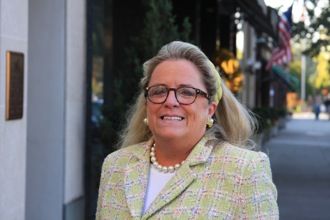From the Mayor: Important Issues For Local Communities

By Mary Marvin, Mayor of Bronxville
Dec. 16, 2020: This past week, I partook in a zoom meeting with my fellow New York State mayors under the auspices of our larger organization, the New York State Conference of Mayors. We got together to prioritize issues germane to our communities for advocacy purposes as the State Legislature begins its new session.
The following is a snapshot of the issues and concerns that directly affect Bronxville.
Unrestricted State Aid
The state has been withholding 20% of local assistance payments as well as highway funds and various grant monies. Municipalities have already experienced 12 years without an increase in unrestricted aid, while school districts have received increases every year to help them maintain essential services. Local governments need and deserve similar annual increases.
Highway assistance has also not been increased since 2013. The formula for distribution also seems to encourage car traffic, not walking traffic as it does not calculate sidewalk miles, purely roadways. Not only should funding be increased, but the formula should be changed to encourage more walkability and with it sustainability.
Funding for Water and Sewer Infrastructure
There is some money in these funds, however its distribution is counterintuitive in that it is not readily available for upgrades or preventive maintenance, rather municipalities are required to demonstrate an emergency situation and not simply a desire to prevent an emergency. In essence, the communities who are not proactive and ignore problems end up being rewarded for their complacency.
Remove the Tax Cap’s Disincentives for Economic Growth
Municipal leaders must be given the ability to invest in their infrastructure, promote downtown revitalization and encourage businesses to locate within their communities. The Tax Cap law should be amended to provide an exclusion from the cap for these kinds of municipal expenditures and public infrastructure repairs. This exclusion would only mirror what school districts and the state government itself are currently granted.
Increase in Gross Receipts Tax Revenue
Under current law, cities and villages have the option to impose a gross receipts tax (GRT )on the gross operating income of utility companies located within their boundaries at a rate of 1%. Unfortunately, the laws governing this tax were written decades ago and have not been amended to account for changes in technology or the marketplace.
Our Mayors’ Conference supports legislation that would permit municipalities, at local option, to impose the GRT at a rate of up to 3%. (This increase has already been granted to the cities of Buffalo, Rochester, Yonkers and Albany by legislation). In addition, in recognition of the predominance of wireless technology and to promote equity in the tax treatment of various types of telecommunication providers, state law must be amended to include cellular services as taxable and subject to local GRT at whatever percentage rate is eventually approved.
Interest Rate on Municipal Judgements
According to current law, judgments against municipalities “shall not exceed 9%”, but almost universally the court applies the full 9% rate which is extraordinarily out of balance with the marketplace. New York local governments are frequently the target of litigation. In an average year, municipalities pay over $1 billion in claims and judgments with the cost by necessity shouldered by taxpayers through higher taxes, increased borrowing or reduction in municipal services. This artificially high interest rate on judgments also creates a barrier to appeal since municipal defendants risk having to pay very substantial interest costs if the appeal is unsuccessful, thus acting as a real deterrent to appeal even if a case appears strong. Legislation that would tie the interest rate on judgments and accrued claims to a market rate would be a fair and significant cost savings at the local level.
Equalize Charges For Vital Records
Historically, the statutory amount that a local registrar could charge for copies of birth and death certificates has been equal to the charge imposed by the State Government itself. However, in 2003, the State fee was raised to $30 without a corresponding change for municipalities whose rate is inflexible at a $10 amount. Taking into account an employee’s time and materials to provide this service results in a monetary loss for local municipalities under the current formula.
Allow Public Safety Considerations in Bail Determination
New York’s recent bail reforms provided some long overdue changes in our State’s bail system. While the central purpose of bail is to ensure that defendants return to court for subsequent court proceedings, it also provides the ancillary benefit of keeping dangerous individuals off the streets. However, under the new law, judges have limited ability to consider public safety as a factor in making bail determinations. An amendment to the law to allow New York’s Criminal Courts to consider the danger that defendants may pose to the public when weighing the option of setting bail could foster safer communities.
Amendment of the Civil Service Employment Process
As communities look for innovative ways to manage the workforce, we are often restricted by arcane civil service rules. Most notably is the famous “rule of three” that requires, in many instances, that the top three scorers on an exam be hired by any municipality before another municipality can reach candidate number four. This often causes amazingly long delays in getting to any candidate who scored fourth and beyond, regardless of whether their talents or skill set that would benefit certain community needs.
Reform of the Scaffold Law
Enacted in 1885, the Scaffold Law holds contractors , employers and property owners absolutely liable for gravity related injuries even if the worker was grossly negligent. Studies have shown that general liability insurance premiums have skyrocketed in New York due to increased litigation resulting from this law. As municipalities are major builders and property owners, the cost is particularly onerous. In New York, the only state in the country with this law on the books, insurance premiums are 300% to 1200% higher than any other state in the country. Legislation that would establish a comparative negligence standard would create a more equitable field of play, holding employees who directly contribute to their injury liable for an apportionment of fault.
Traffic Safety
Currently under New York State law ,cities and villages may establish area-wide speed limits of not less than 30mph for roads in the municipality’s jurisdiction. However, 30 mph is too fast on many city and village streets. It would be advisable to amend the law to allow cities and villages to impose area speed limits of not less than 25 mph.
Red light and speed cameras have been authorized on a limited basis in specific municipalities across New York State. This technology is proving to be a cost-effective way for local governments to help reduce running red lights and speeding in pedestrian friendly neighborhoods and school zones. Consequently, the authority to install and enforce red light and speed cameras should be expanded state wide at local option.
Pictured: Mary Marvin
Photo by A. Warner
Editor's note: As a public service, MyhometownBronxville publishes articles from local institutions, officeholders, and individuals. MyhometownBronxville does not fact-check statements therein, and any opinions expressed do not necessarily reflect the thinking of its staff.
Government & History Directory
Bronxville is a quaint village (one square mile) located just 16 miles north of midtown Manhattan (roughly 30 minutes on the train) and has a population of approximately 6,500. It is known as a premier community with an excellent public school (K-12) and easy access to Manhattan. Bronxville offers many amenities including an attractive business district, a hospital (Lawrence Hospital), public paddle and tennis courts, fine dining at local restaurants, two private country clubs and a community library.
While the earliest settlers of Bronxville date back to the first half of the 18th century, the history of the modern suburb of Bronxville began in 1890 when William Van Duzer Lawrence purchased a farm and commissioned the architect, William A. Bates, to design a planned community of houses for well-known artists and professionals that became a thriving art colony. This community, now called Lawrence Park, is listed on the National register of Historic Places and many of the homes still have artists’ studios. A neighborhood association within Lawrence Park called “The Hilltop Association” keeps this heritage alive with art shows and other events for neighbors.
Bronxville offers many charming neighborhoods as well as a variety of living options for residents including single family homes, town houses, cooperatives and condominiums. One of the chief benefits of living in “the village” is that your children can attend the Bronxville School.
The Bronxville postal zone (10708, known as “Bronxville PO”) includes the village of Bronxville as well as the Chester Heights section of Eastchester, parts of Tuckahoe and the Lawrence Park West, Cedar Knolls, Armour Villa and Longvale sections of Yonkers. Many of these areas have their own distinct character. For instance, the Armour Villa section has many historic homes and even has its own newsletter called “The Villa Voice” which reports on neighborhood news.
Link to Village of Bronxville One Square Mile Monthly Newsletter
Village of Bronxville Administrative Offices
337-6500
Open 9:00am - 4pm excluding holidays and weekends
Bronxville Police Department
337-0500
Open 24 hours
Bronxville Parking Violations
337-2024
Open 9:00am - 4pm excluding holidays and weekends
Bronxville Fire Deparment
793-6400

















